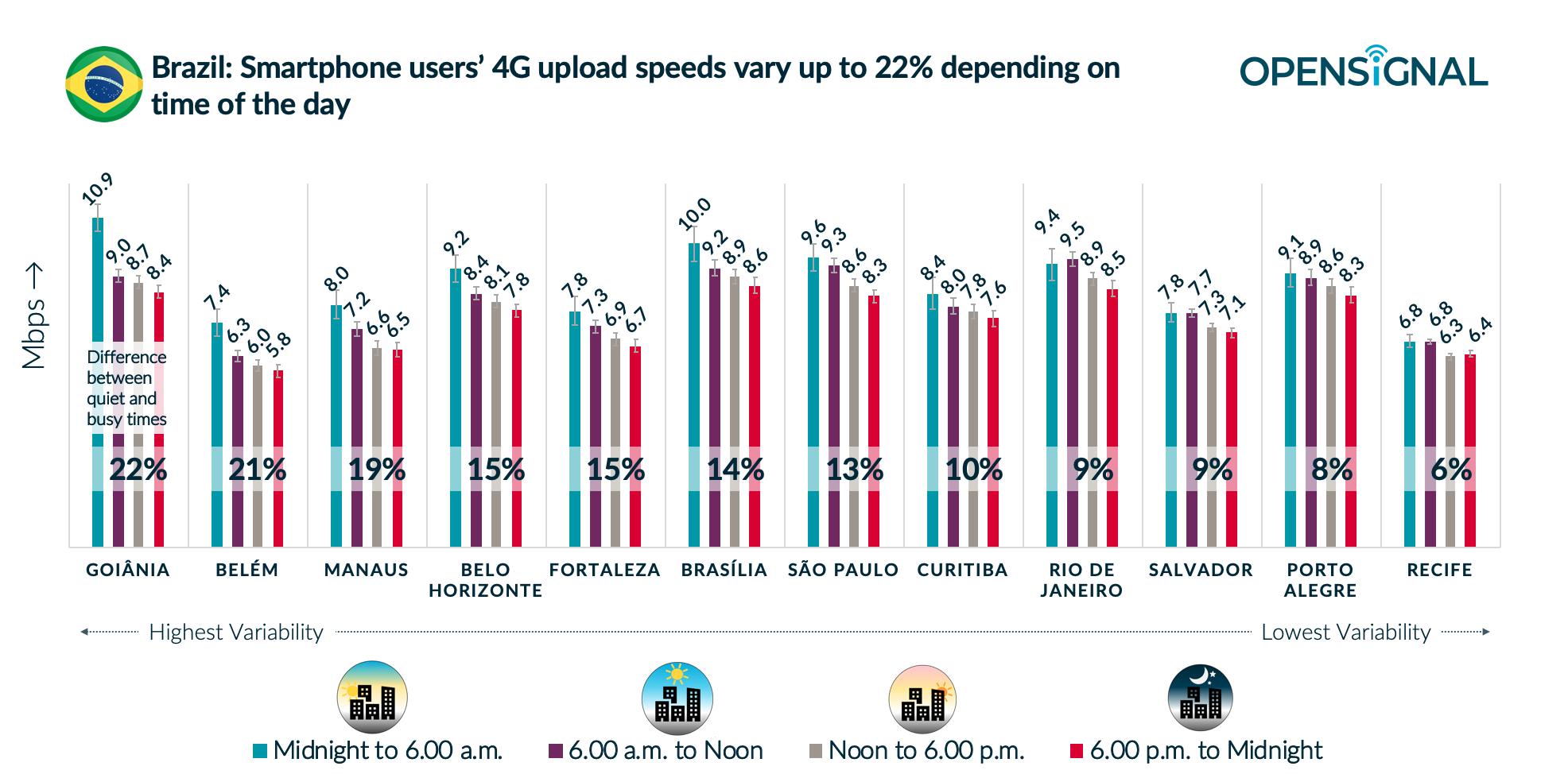For decades user experience on mobile internet has been largely defined by download speeds, but with changing usage patterns and consumption habits upload speed is becoming increasingly important. Today, 81% of Brazil’s population is actively engaged on social media spending approximately three and a half hours on social platforms every day. With this increasing popularity in social media usage, Brazillian users now engage in activities such as sharing media content, online gaming and video chatting more often than ever.
In order to understand the true user experience while upstreaming, Opensignal analyzed 4G Upload Speeds in the 12 largest cities of Brazil and found that upload speeds vary depending on the time of day. Our users enjoyed the fastest speeds between midnight and 6 a.m. in a majority of the cities, with users in Rio de Janeiro experiencing fast speeds in the morning as well. The slowest speeds were experienced in each of the cities between 6 p.m. and midnight.
We found a consistent trend in all 12 cities: Belém, Belo Horizonte, Brasília, Curitiba, Fortaleza, Goiânia, Manaus, Porto Alegre, Recife, Rio de Janeiro, Salvador, and São Paulo — namely, that users experienced widely different speeds across different times of the day. The average 4G Upload Speeds drop during the busiest hours — 6 p.m. until midnight — with users in Belém experiencing the slowest 4G Upload Speeds at 5.8 Mbps, followed by Recife at 6.4 Mbps, Manaus at 6.5 Mbps, Fortaleza at 6.7 Mbps and Salvador at 7.1 Mbps. On the other hand, when the networks are less congested — from midnight until 6 a.m. — users enjoy faster 4G Upload Speeds on average, with Goiânia hitting the highest speed of 10.9 Mbps, followed by Brasília, São Paulo, Rio de Janeiro, and Belo Horizonte at 10 Mbps, 9.6 Mbps, 9.4 Mbps, and 9.2 Mbps.
We found that smartphone users can experience 4G Upload Speeds between 6% and 22% faster by connecting to the network at a different time of day — with Recife having the most consistent speeds and Goiânia the highest variance.
Why is this occurring? The upload speeds experienced by users largely depend on the network capacity and the number of active online users on the network at that particular time. At night when most people are asleep — and fewer devices are connected to mobile networks — the upload speeds are the fastest. Users in 8 out of the 12 cities experienced 4G Upload Speeds of at least 8 Mbps on average between midnight and 6 a.m.
However, starting from 6 a.m. — as people wake up and more devices access 4G networks — upload speeds start to decline, and tend to be the slowest during peak hours between 6 p.m. and midnight when the networks are burdened with congestion. A large number of connected devices puts pressure on the network and erodes users’ network experience. The wide range between a city’s fastest and the slowest speed smartphone users experience during different times of the day shows the challenge Brazil’s operators face from the need to support vast numbers of smartphone users consuming ever-increasing amounts of mobile data at all hours of the day.
As mobile users in Brazil are rapidly moving away from mere content consumption to content creation and sharing, the operators with the most powerful upstream connection will be best positioned to continue to offer a great experience. At present, Brazillian mobile users benefit from the deployment of the 700 MHz band — which we found improved the mobile network experience in Brazil. The new band is characterized by low frequency and high propagation, making it ideal for increased 4G coverage, but more of a temporary solution towards increased capacity. That being said, with the auction of 5G licenses planned for next year, the rollout of high capacity 5G networks could pave the way for Brazil’s social media-savvy users to enjoy a consistent and seamless upstreaming experience around the clock.
Opensignal Limited retains ownership of this insight including all intellectual property rights, data, content, graphs & analysis. Reports and insights produced by Opensignal Limited may not be quoted, reproduced, distributed, published for any commercial purpose (including use in advertisements or other promotional content) without prior written consent. Journalists are encouraged to quote information included in Opensignal reports and insights provided they include clear source attribution. For more information, contact [email protected].
